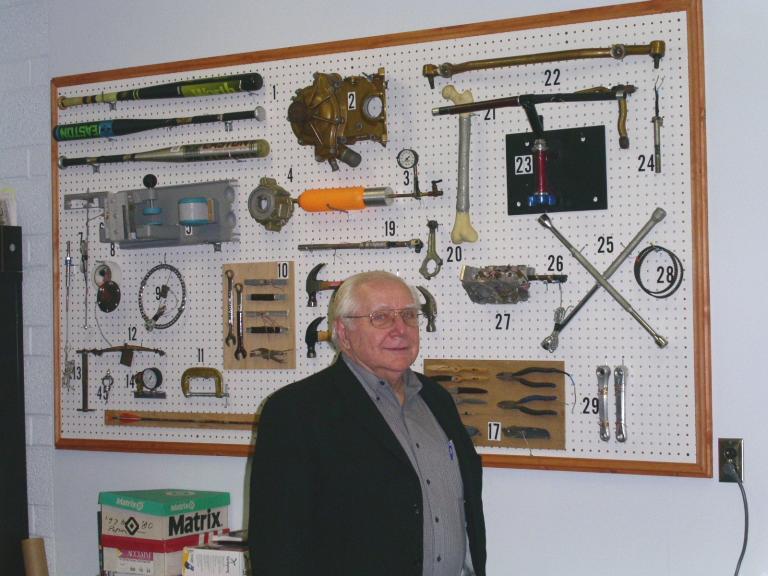
It is one of those things many of us take for granted – turning on the lights when we walk into a room, flipping on the radio or the blender, but for children with disabilities that impair dexterity, these are challenging tasks.
Enter a team of Kettering students from Dr. Henry Kowalski’s Experimental Mechanics class. Armed with four and half years of engineering education they took on the challenge of making electrical toys and common household appliances more accessible to handicapped children enrolled at Webb Elementary School in Hazel Park, Mich.
“Children with disabilities do not have the manual dexterity necessary to use common household switches,” said Monica Denis, a senior Mechanical and Industrial Engineering major from Clarkston, Mich., “and toys that are adapted for these children are often very expensive,” she added. Denis and fellow students Shana Paciocco, Beau Jewell, Heather Kaler and Eric Adams, took typical toys and retrofitted them with modified lollipop switches.
Lollipop switches, which look just like they sound – large and round and flat, normally require constant pressure to remain active, so the group modified them to include a relay with two inputs, one for “on” and one for “off.”
In analyzing the range of switches available, the group tried a variety of switch styles. “The biggest hurdle for us as a group was to find what kind of button would work best,” Denis said. “We ordered ‘lollipop’ switches that would work well as insofar as they were large and very sensitive to touch, but the switch was a momentary switch and would not keep the object turned on,” she added.
The group also tried a button found on a typical piece of manufacturing machinery. This button had more resistance but once it was pushed the object would stay on. They also tried using a typical light dimmer switch. They found the dimmers were easy to push and would stay turned on or off, but the button was smaller, which increased difficulty for handicapped users.
“We decided to modify the dimmer switch by removing the dimming application and adding a larger top to the switch,” said Denis, “we used larger lids from food containers, such as the lid off of an animal crackers container. We manufactured a larger base for the new larger button and mounted the electrical parts inside of the new base,” she added.
The toys they adapted with modified lollipop switches included a rotating disco ball with different colored flashing lights and a mechanized butterfly with optic fiber wings that lit up, changed color and moved. “We tried to find toys that would ‘do’ something and keep their attention to help facilitate mental development,” Denis said.
They also adapted common household appliances with the relay that was made so they could plug in anything using a normal 110V plug,” Denis said, “there were two larger buttons hooked to the circuit that would function as the on/off switches.”
This allowed the handicapped students to learn to operate toasters, blenders and microwave ovens to increase their independence. “Being able to use common household appliances gives these kids the ability to control their environment,” Denis explained during the final project presentation for Experimental Mechanics.
The project put a different spin on engineering for the Kettering students, according to Denis. “We used everyday objects that we take for granted and made them so children with disabilities could use them as well. It would never have occurred to us that there are people who don't have the motor skills to turn on a dimmer switch until this project,” she said.
While identifying the most efficient switch was a challenge, an equally difficult challenge was deciding what toys to modify with only 11 weeks to do the research, accomplish the design and manufacture of the device and still have the opportunity to take the toys to the handicapped children for testing.
“The most rewarding aspect to the project by far was when we took the toys to the school where we met several of the students,” Denis said. One student, confined to a wheelchair and barely able to move her muscles was able to turn one and off the disco ball. “The smile on her face when she was able to turn it on and off was the most rewarding experience! Something that is so simple for us to do, making these new toys/buttons, brought her so much joy,” she added.
The Kettering students felt areas for future development could include toys that have musical capabilities (for visually impaired students), a motorized tricycle to help disabled children to associate their foot movement with forward movement, buttons that are wireless – possibly using an infrared signal to operate the toy and more relays.
The Kettering students were recognized at a school board meeting for Hazel Park schools, by Don Badaczewski, Special Education director. He commended Armen
Gulian, Speech therapist, for her efforts in developing the partnership with Kettering University, adding that he hoped it would become an ongoing, mutually beneficial, relationship.
Written by Dawn Hibbard
810.762.9865
dhibbard@kettering.edu